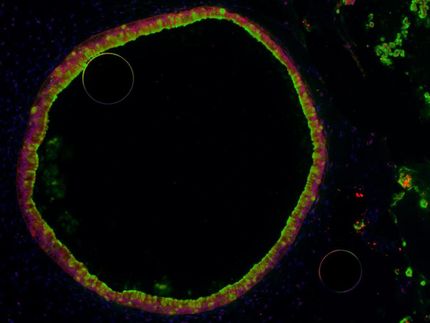DNA markers distinguish between harmless, deadly bacteria
The virulent pathogen that causes the disease tularemia, or "rabbit fever," was weaponized during past world wars and is considered a potential bioweapon. Through a new study of the coccobacillus Francisella, Los Alamos National Laboratory researchers are working to use DNA markers to discern related but relatively harmless species as they are identified and to provide a means to distinguish them from the harmful F. tularensis.

Scanning electron micrograph of a murine macrophage infected with Francisella tularensis strain LVS. Macrophages were dry-fractured by touching the cell surface with cellophane tape after critical point drying to reveal intracellular bacteria. Bacteria (colorized in blue) are located either in the cytosol or within a membrane-bound vacuole.
NIAID
"This large study is particularly notable for having used 31 publicly available genomes plus select genes from about 90 additional isolates," said corresponding author Cheryl Kuske of the Bioenergy & Biome Sciences group at Los Alamos National Laboratory.
The group's work includes developing a comprehensive, genomics-based understanding of organisms and their environment as part of the Lab's energy-security research into energy sources and their impact. "We conducted standard single and multi-gene comparisons with whole-genome approaches and identified potential virulence factors to discriminate new species from among the more traditional set. Thanks to coordination with the Centers for Disease Control and Prevention (CDC), we now have a framework to identify new isolates or environmental detections even if only partial information is available," Kuske said.
Humans can easily develop tularemia through incidental contact with infected rabbits, cats, rodents or other animals (and the ticks or fleas that may be on them). The disease manifests in a variety of forms: fever and chills with joint pain, cough or pneumonia, or abdominal pain and distress. Fatality rates range, depending on the form of the disease, from 2 percent to 24 percent, according to CDC data. Due to this severity, the CDC has made tularemia a reportable disease, and like the pathogens causing anthrax and plague, it is considered a bioweapon.
Through detailed genome comparisons, sequence-alignment algorithms and other bioinformatics tools run on Los Alamos computers, the Los Alamos team identified features that differentiate among F. tularensis and other novel clinical and environmental Francisella isolates, providing a knowledge base for comparison of new sequences from clinical or environmental surveys.
"For residents of areas such as the Southwest, where tularemia outbreaks are endemic and potentially life threatening, having more identification tools at hand is extremely valuable," Kuske said. The distribution of these isolates is global, however, suggesting a worldwide distribution of Francisella organisms that inhabit fish, ticks and a variety of environmental sources. The team designated four new species groups within the genus; Francisella opportunistica, an opportunistic pathogen of immune compromised patients; Francisella salina and Francisella uliginis, environmental isolates from coastal seawater near Galveston, TX; and Francisella frigiditurris from cooling-tower water in California.
Original publication
Most read news
Original publication
Jean F. Challacombe, Jeannine M. Petersen, La Verne Gallegos-Graves, David Hodge, Segaran Pillai and Cheryl R. Kuske; "Whole genome relationships among Francisella bacteria of diverse origin define new species and provide specific regions for detection"; Appl. and Environ. Microbiology; 2016
Topics
Organizations
Other news from the department science

Get the life science industry in your inbox
By submitting this form you agree that LUMITOS AG will send you the newsletter(s) selected above by email. Your data will not be passed on to third parties. Your data will be stored and processed in accordance with our data protection regulations. LUMITOS may contact you by email for the purpose of advertising or market and opinion surveys. You can revoke your consent at any time without giving reasons to LUMITOS AG, Ernst-Augustin-Str. 2, 12489 Berlin, Germany or by e-mail at revoke@lumitos.com with effect for the future. In addition, each email contains a link to unsubscribe from the corresponding newsletter.
Most read news
More news from our other portals
Last viewed contents
Cri_du_chat
Heterotrimeric_G_protein
Human_mitochondrial_DNA_haplogroup
The_Seven_Daughters_of_Eve
Category:Enteral_feeding
Category:Genes_on_chromosome_8
Category:Bird_anatomy
Peach_latent_mosaic_viroid






















































